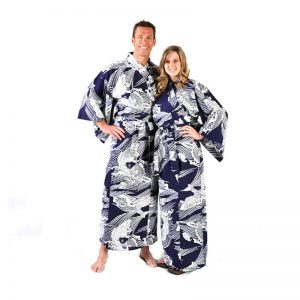For almost three decades, we’ve been dedicated to offering high-quality and unique Japanese Kimonos and Yukatas to our customers. With a wide variety of styles and colors to choose from, we know how overwhelming it can be to find the perfect one. One of the biggest frustrations is that there isn’t a centralized and reliable source of data to help determine the most popular choices.
However, at Chopa, we’re breaking this mold by keeping close tabs on the purchases of our thousands of customers globally. Unlike other sources of sales data, our analytics are based on actual sales. This makes it the most complete and trustworthy data available. Each month, we compile this data and provide an honest and factual list of the best-selling kimonos and yukatas. This is produced with customer feedback made through purchases, not a blind voting system. Trust us to provide you with the most accurate information when it comes to finding the perfect Japanese kimono or yukata.
Yukata – Pink Cherry Blossom – Introducing the Japanese Yukata: Versatile and Stylish. Step into the world of tradition and fashion with the timeless Japanese Yukata. These elegant robes are a must-have addition to every woman’s wardrobe. Suitable for any occasion – from formal events to casual outings. Immerse yourself in the vibrant colors and textures of Japan with this exquisite robe.
The gentle pink background adorned with delicate cherry blossoms, Japan’s national flower, exudes a sense of tranquility and peace. Crafted with expertise in Japan using 100% cotton, this yukata is designed to last with a shrink-resistant finish for easy care. For optimal results and to prolong its lifespan, simply machine wash it with cold water. Complete with traditional butterfly sleeves and a matching belt, this yukata combines comfort and style effortlessly. Elevate your fashion game with the Japanese Yukata – the epitome of timeless elegance.
Kimono – Embroidered Samurai – Experience the elegance of this authentic Japanese Samurai robe, crafted with care from 100% shantung cotton. A unique weaving technique creates a luxurious ribbed effect, showcasing a distinctive vintage flair. The slubbed cotton fabric offers a soft touch, breathability, and a linen-like appearance.
Embrace the spirit of the Samurai with the eye-catching 6″ square, satin gold embroidered “Samurai” calligraphy symbol on the back and the elegant red Sakura crests on each front panel. Complete the look with the included matching belt. To maintain its pristine condition, simply hand wash in warm water and allow it to drip dry. Avoid dry cleaning for the best results. Indulge in the rich history and superior craftsmanship of this traditional Samurai robe.
Yukata – Tree of Life – Introducing our men’s Yukata featuring a distinctive Japanese tortoise print. This ancient geometric pattern dates back to 2000 B.C. and symbolizes stability. Samurai warriors valued this design, and its popularity in old Japan continues to this day. Wear it on special occasions or in battle to channel the spirit of the samurai. Made with 100% cotton, this robe boasts a sleek black, gray, and white color palette. Its traditional butterfly sleeves add an elegant touch. Easy to care for and machine washable, it will be a long-lasting addition to your wardrobe. Complete with a matching belt, this Yukata is proudly made in Japan by master clothiers.
Kimono – Black Crane and Peony – Experience elegance and tradition with this stunning Japanese Kimono robe. Adorned with a captivating palette of peony flowers and graceful cranes, it symbolizes wealth, honor, and prosperity. The striking black background perfectly highlights the bold pink, purple, gray, and white peonies, as well as the flying cranes and Sakura blossoms. Gold accents add a touch of natural beauty.
Crafted with utmost care, this women’s kimono is made of 100% soft and luxurious cotton sateen. This premium material is not only breathable but also highly durable. Made in Japan, it exudes true authenticity. And to complete the ensemble, a matching belt is included.For easy care, simply machine wash cold for the best results. Elevate your style and embrace the beauty of Japanese culture with this exquisite kimono robe.
Yukata – Red Crane and Tree – Experience the beauty and joy of Japan with this stunning women’s robe. Adorned with the symbolic crane, known as the bird of happiness, this robe brings a touch of elegance to your loungewear collection. Against a vibrant red background, delicate Japanese pine trees create a calming ambiance with shades of blues and greens, accented by touches of gold. The intricately detailed crane is showcased in shades of white and gold, adding a touch of grace.
Crafted in Japan using 100% cotton with a shrink-resistant finish, this yukata is not only beautiful but also easy to care for. Simply machine wash with cold water for best results. Whether you’re relaxing at home or enjoying a day at the beach or pool, this red robe is the perfect cover-up. Embrace tradition with its butterfly sleeves, while a matching sash completes the ensemble.
Immerse yourself in Japanese culture and style with this women’s robe. Indulge in the comfort and elegance it offers while embracing the symbolism and beauty of the crane.
Our selection of kimonos and yukatas from Japan is a testament to the timeless appeal of these traditional garments. Shop our online store now for your Japanese robe.














